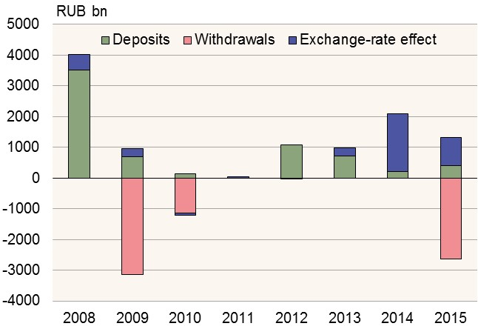BOFIT Weekly Review 03/2016
Russia’s Reserve Fund shrank last year substantially
Russia established its Reserve Fund to cover possible fiscal deficits in the event of economic weakness. The money is invested in liquid foreign-currency assets. For the first time since 2010, the government last year dipped into the Reserve Fund to cover budget expenses. As a result, the value of the Reserve Fund shrank last year by nearly $40 billion, standing at around $50 billion at year’s end.
The depreciation of the ruble, however, supported the value of the Reserve Fund in ruble terms and hence the purchasing power of the assets as most budget spending is denominated in rubles. At end-December, the Reserve Fund held 3.6 trillion rubles (nearly 5 % of GDP). This year’s budget act dedicates 2.1 trillion rubles in Reserve Fund assets to covering the deficit. The average $50-a-barrel oil price assumed in the 2016 budget, however, is about double the current oil price. Preliminary estimates from Russia’s finance ministry suggest the Reserve Fund could be drained by the end of this year if spending is not cut further.
Russia’s other big rainy-day fund, the National Welfare Fund, is meant to fund the pension system, but during crisis periods has been used to support domestic banks and firms through e.g. deposits and bond purchases. The stated value of the National Welfare Fund is unaffected by such measures as use of its assets in this way are treated as investment. Thus, nearly all changes in the National Welfare Fund’s valuation come from exchange rate shifts. At end-2015, the Reserve Fund stood at $72 billion. Of that, $48 billion (3.5 trillion rubles) was in liquid foreign-currency assets.
Changes in the value of Russia’s Reserve Fund

Source: Russian Ministry of Finance